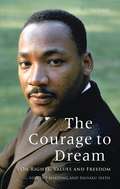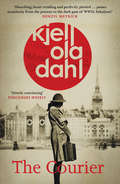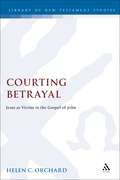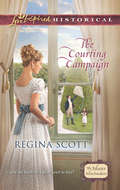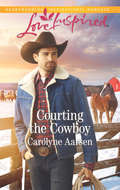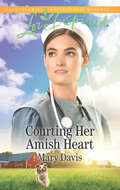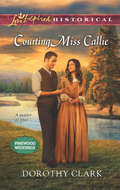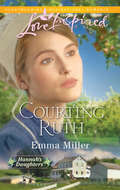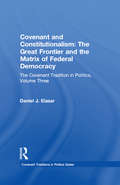- Table View
- List View
The Courage of Hopelessness: Chronicles of a Year of Acting Dangerously
by Slavoj ŽižekIn these troubled times, even the most pessimistic diagnosis of our future ends with an uplifting hint that things might not be as bad as all that, that there is light at the end of the tunnel. Yet, argues Slavoj Žižek, it is only when we have admitted to ourselves that our situation is completely hopeless - that the light at the end of the tunnel is in fact the headlight of a train approaching us from the opposite direction - that fundamental change can be brought about. Surveying the various challenges in the world today, from mass migration and geopolitical tensions to terrorism, the explosion of rightist populism and the emergence of new radical politics - all of which, in their own way, express the impasses of global capitalism - Žižek explores whether there still remains the possibility for genuine change. Today, he proposes, the only true question is, or should be, this: do we endorse the predominant acceptance of capitalism as a fact of human nature, or does today's capitalism contain strong enough antagonisms to prevent its infinite reproduction? Can we, he asks, move beyond the failure of socialism, and beyond the current wave of populist rage, and initiate radical change before the train hits?
The Courage To Be Catholic: Crisis, Reform And The Future Of The Church
by George WeigelWhen sexual scandals rocked the American Catholic Church, many observers and faithful alike called on the church to abandon its tenets on the vocation of the priesthood and sexuality outside marriage -- to, in effect, become more Protestant. Acclaimed theologian and best-selling author George Weigel saw the crisis differently: as a crisis of fidelity to the true essence of Catholicism.In this well-reviewed book that touched a chord with so many practicing Catholics, Weigel examines the scandal in the context of church history, and exposes the patterns of dissent and self-deception that became entrenched in seminaries, among priests, and ultimately among the bishops who failed their flock by thinking like managers instead of apostles. But, Weigel reminds us, in the Biblical world a "crisis" is also a time of great opportunity, an invitation to deeper faith. With honesty and critical rigor, Weigel sets forth an agenda for genuine reform that challenges clergy and laity alike to lead more integrally Catholic lives. More than just a response to recent failures, The Courage to Be Catholic is a bracing, forward-looking call to action, and a passionate embrace of life lived in faith.
The Courage to Dream: On Rights, Values and Freedom
by Vincent Harding Daisaku Ikeda'I have a dream' declared Martin Luther King in 1967. Those words, which echoed round the world, soon became immortal. Slain by an assassin's bullet, King gave his life in the cause of eradicating racism, eliminating poverty and resolutely opposing all forms of war and violence. This dialogue brings together two figures who likewise have striven in all their activities to promote peace and fight discrimination: one a Christian theologian, historian and nonviolent activist who got to know King personally and who moved in 1958 from Chicago to the American South to participate in the nascent struggle for civil rights; the other a foremost Buddhist leader who has been inspired in his own thinking by King's example. Vincent Harding and Daisaku Ikeda here bring the wisdom of their respective traditions and experiences to reflect on the personal cost of fighting for justice, and the courage that that entails. Their conversations range widely, across issues that include war and violence, the continuing blight in America of institutionalized racism, the need to overcome in society disparities of wealth and the consequent dangers of materialism and consumerism. In gripping first-hand testimony, Vincent Harding places both King and himself in the context of world changing events, such as the Montgomery bus boycott sparked by Rosa Parks; the famous March on Washington; the signing of the Civil Rights Act; King's growing opposition to the Vietnam War; and his assassination in 1968. This testimony includes discussion of Vincent Harding's central role as speech-writer to Dr King – especially the seminal speech 'Beyond Vietnam', which gained King many enemies – and reflection on his own imprisonment after leading a civil rights demonstration at Albany in 1962. Daisaku Ikeda similarly draws on his own rich experience of adversity, and shows that Buddhism recognizes, like Martin Luther King, that the painful story of the past is only half the story: with faith and courage one must also look to the possibilities of the future. It is just such a courage that sees potential in every human being: a vision of equality that gives all people, in the end, the courage to dream
The Courage To Dream and The Power Of Love
by Margaret DaleyThe Power of Love When Rebecca Michaels returns to her mother's home with her troubled son and special needs baby, she feels certain that God has abandoned her. Then Officer Gabriel Stone steps in with his firm hand, solid faith and a heart that needs healing…
The Courage to Teach: Exploring the Inner Landscape of a Teacher's Life
by Parker J. Palmer"This book is for teachers who have good days and bad -- and whose bad days bring the suffering that comes only from something one loves. It is for teachers who refuse to harden their hearts, because they love learners, learning, and the teaching life." - Parker J. Palmer [from the Introduction] Teachers choose their vocation for reasons of the heart, because they care deeply about their students and about their subject. But the demands of teaching cause too many educators to lose heart. Is it possible to take heart in teaching once more so that we can continue to do what good teachers always do -- give heart to our students? In The Courage to Teach, Parker Palmer takes teachers on an inner journey toward reconnecting with their vocation and their students -- and recovering their passion for one of the most difficult and important of human endeavors.
The Courage to Teach Guide for Reflection and Renewal
by Parker J. Palmer20th ANNIVERSARY EDITION The Courage to Teach Guide for Reflection & Renewal is a helpful companion to Parker J. Palmer's classic work on restoring identity and integrity to professional life. A superb resource for those who wish to extend their exploration of the ideas in The Courage to Teach, as individuals or part of a study group, the Guide provides practical ways to create "safe space" for honest reflection and probing conversations and offers chapter-by-chapter questions and exercises to further explore the many insights in The Courage to Teach. The bonus online content includes a 70-minute interview with Parker Palmer, in which Palmer reflects on a wide range of subjects including the heart of the teacher, the crisis in education, diverse ways of knowing, relationships in teaching and learning, approaches to institutional transformation, and teachers as "culture heroes." Discussion questions related to the topics explored in the interview have been integrated into the Guide, giving individuals and study groups a chance to have "a conversation with the author" as well as an engagement with the text.
The Courage to Teach Guide for Reflection and Renewal
by Parker J. Palmer20th ANNIVERSARY EDITION The Courage to Teach Guide for Reflection & Renewal is a helpful companion to Parker J. Palmer's classic work on restoring identity and integrity to professional life. A superb resource for those who wish to extend their exploration of the ideas in The Courage to Teach, as individuals or part of a study group, the Guide provides practical ways to create "safe space" for honest reflection and probing conversations and offers chapter-by-chapter questions and exercises to further explore the many insights in The Courage to Teach. The bonus online content includes a 70-minute interview with Parker Palmer, in which Palmer reflects on a wide range of subjects including the heart of the teacher, the crisis in education, diverse ways of knowing, relationships in teaching and learning, approaches to institutional transformation, and teachers as "culture heroes." Discussion questions related to the topics explored in the interview have been integrated into the Guide, giving individuals and study groups a chance to have "a conversation with the author" as well as an engagement with the text.
Courage Under Fire (True Blue K-9 Unit #8)
by Sharon DunnA killer in the shadows watches…and waitsThe thrilling True Blue K-9 Unit continues
The Courier
by Kjell Ola DahlThe international bestselling godfather of Nordic Noir takes on one of the most horrific periods of modern history, in a stunning standalone thriller … NUMBER ONE BESTSELLER‘The Courier is a stylish stand-alone thriller from the godfather of Scandi noir … Ola Dahl ratchets up the tension from the first pages and never lets go’ The Times‘Cleverly braiding together past and present, the who and why of murder and betrayal are unpicked. The detail is impressive’ Daily MailIn 1942, Jewish courier Ester is betrayed, narrowly avoiding arrest by the Gestapo. In a great haste, she escapes to Sweden, saving herself. Her family in Oslo, however, is deported to Auschwitz. In Stockholm, Ester meets the resistance hero, Gerhard Falkum, who has left his little daughter and fled both the Germans and allegations that he murdered his wife, Åse, who helped Ester get to Sweden. Their burgeoning relationship ends abruptly when Falkum dies in a fire.And yet, twenty-five years later, Falkum shows up in Oslo. He wants to reconnect with his daughter. But where has he been, and what is the real reason for his return? Ester stumbles across information that forces her to look closely at her past, and to revisit her war-time training to stay alive…Written with Dahl's trademark characterization and elegant plotting, The Courier sees the hugely respected godfather of Nordic Noir at his best, as he takes on one of the most horrific periods of modern history, in an exceptional, shocking thriller.‘Absorbing, heart-rending and perfectly plotted. Kjell Ola Dahl’s The Courier passes seamlessly from the present to the dark past of WWII. Fabulous!’ Denzil Meyrick‘Skilfully juggling three Oslo timelines — in 1942, 1967 and 2015 — Dahl starts his story with Germany’s occupation of Norway and the work of those who tried to resist, then brings his characters forward to a post-war unravelling of what really happened in those dangerous days — and the traumatic rewriting of personal stories’ The Times Crime Club‘The Courier is very good on the socio-political situation of the time, the relationship between Norway and neutral neighbour Sweden. This is a gritty but ultimately uplifting story. Superbly translated by Don Bartlett’ NB Magazine‘A fascinating, intricate, provocative read, set in motion by events in 1942, and brilliantly highlighting human need and emotions … ‘The Courier’ sent a shiver coursing through me, it is a truly eloquent and rewarding tale, and oh that ending!’ LoveReading‘Written with Dahl’s trademark characterisation and clever plotting, The Courier sees one of Norway’s most critically acclaimed authors at his best … This stunning and compelling wartime thriller is reminiscent of the writing of John Le Carré and William Boyd’ New Books Magazine‘Utterly convincing’ Publishers Weekly‘Kjell Ola Dahl’s novels are superb. If you haven’t read one, you need to – right now’ William Ryan‘More than gripping’ European Literature Network‘The perfect example of why Nordic Noir has become such a popular genre’ Reader’s Digest‘It all comes together, of course, in the kind of masterful, detailed plotting that Dahl is known for … the power of The Courier is how Dahl has given a complex, human face to such an inhuman tragedy’ Crime Fiction Lover‘Atmospheric thriller with lots of great twists and loved the scandi wartime story in particular. Gripping will be recommending to readers’ Edgy Books
Courtesans and Tantric Consorts: Sexualities in Buddhist Narrative, Iconography, and Ritual
by Serinity YoungThe wisest teachings of Buddhism say that, like all oppositions, one must move beyond gender. But as Serinity Young shows in this enlightening work, the rhetoric of Buddhist texts, the symbolism of its iconography, and the performative import of its rituals, tell different, and often contradictory, stories. In Courtesans and Tantric Consorts, Serinity Young takes the reader on a journey through more than 2000 years of biographical writings, iconographic depictions, and ritual practices revealing Buddhism's deep struggles with gender.Juxtaposing empowering images of women with their textual repudiation, beginning with the Buddha himself who abandoned his wife; tantric courtesans who are considered necessary to male enlightenment with fertility rituals designed to ensure male offspring; tales of gender-bending gods and goddesses with all male heavens; Serinity Young draws on a vast range of sources to reveal the colourful, and often troubling, mosaic of beliefs that inform Buddhist views about gender and sexuality.
Courtesans and Tantric Consorts: Sexualities in Buddhist Narrative, Iconography, and Ritual
by Serinity YoungThe wisest teachings of Buddhism say that, like all oppositions, one must move beyond gender. But as Serinity Young shows in this enlightening work, the rhetoric of Buddhist texts, the symbolism of its iconography, and the performative import of its rituals, tell different, and often contradictory, stories. In Courtesans and Tantric Consorts, Serinity Young takes the reader on a journey through more than 2000 years of biographical writings, iconographic depictions, and ritual practices revealing Buddhism's deep struggles with gender.Juxtaposing empowering images of women with their textual repudiation, beginning with the Buddha himself who abandoned his wife; tantric courtesans who are considered necessary to male enlightenment with fertility rituals designed to ensure male offspring; tales of gender-bending gods and goddesses with all male heavens; Serinity Young draws on a vast range of sources to reveal the colourful, and often troubling, mosaic of beliefs that inform Buddhist views about gender and sexuality.
Courting The Amish Nanny (Amish of Serenity Ridge #1)
by Carrie LighteShe’ll be their Christmas nanny…But a permanent family’s not part of her plans.
Courting Betrayal: Jesus as Victim in the Gospel of John (The Library of New Testament Studies #161)
by Helen OrchardThis study explores the dynamics of violence within John's Gospel, focusing on the portrayal of the character of Jesus. It offers an understanding of the Johannine Jesus that counters the traditional model of a serene figure who maintains sovereign control over his environment. Establishing the prevalence of material indicating opposition to Jesus, it argues that his experience and perception of victimization are key to his identity. Furthermore, it is suggested that Jesus colludes with his victimizers, raising the issue of who is responsible for his betrayal and death. Drawing on the disciplines of victimology, literary criticism and liberation theology, the work comprises targeted exegesis of substantial portions of the Gospel, revealing the prominence of the theme of violence and raising a number of christological questions.
The Courting Campaign: The Courting Campaign The Wife Campaign The Husband Campaign (The Master Matchmakers #1)
by Regina ScottEmma Pyrmont has no designs on handsome Sir Nicholas Rotherford—at least not for herself. As his daughter's nanny, she sees how lonely little Alice has been.
Courting The Cowboy: The Doctor's Texas Baby; Courting The Cowboy; Falling For The Single Mom (Cowboys of Cedar Ridge #1)
by Carolyne AarsenMeeting the Cowboy's Family
Courting Her Amish Heart: Amish Rescue Courting Her Amish Heart (Prodigal Daughters #1)
by Mary DavisA doctor or an Amish wife? She can choose to be only one…
Courting Her Prodigal Heart: Courting Her Prodigal Heart A Cowboy In Shepherd's Crossing Beneath Montana Skies (Prodigal Daughters #3)
by Mary DavisMother-to-be’s Amish Homecoming
Courting Her Secret Heart: Courting Her Secret Heart Reunited With The Rancher Snowbound With The Best Man (Prodigal Daughters #2)
by Mary DavisCaught between two worlds…
Courting Katarina (Mills And Boon Love Inspired Ser. #No. 134)
by Carol StewardCOULD A TOSSED BOUQUET PREDICT THE NEXT BRIDE?
Courting Miss Callie (Pinewood Weddings #2)
by Dorothy ClarkSEEKING TRUE LOVE Stunningly beautiful Callie Conner is sick of being pursued by shallow suitors. She wants a man of faith, honesty, and moral integrity who will love and value her for more than her appearance. So she flees to her aunt’s hotel, where she soon finds herself falling for the handsome new stable hand.
Courting Ruth: Restless Hearts The Doctor's Blessing Courting Ruth (Mills And Boon Love Inspired Ser. #Bk. 1)
by Emma MillerAmish widow Hannah Yoder prays her daughters will each find a husband someday. Still, sensible Ruth believes it's God's will that she stay home and help care for her younger sisters.
Courting Sanctity: Holy Women and the Capetians
by Sean L. FieldThe rise of the Capetian dynasty across the long thirteenth century, which rested in part on the family's perceived sanctity, is a story most often told through the actions of male figures, from Louis IX's metamorphosis into "Saint Louis" to Philip IV's attacks on Pope Boniface VIII. In Courting Sanctity, Sean L. Field argues that, in fact, holy women were central to the Capetian's self-presentation as being uniquely favored by God. Tracing the shifting relationship between holy women and the French royal court, he shows that the roles and influence of these women were questioned and reshaped under Philip III and increasingly assumed to pose physical, spiritual, and political threats by the time of Philip IV's death. Field's narrative highlights six holy women. The saintly reputations of Isabelle of France and Douceline of Digne helped to crystalize the Capetians' claims of divine favor by 1260. In the 1270s, the French court faced a crisis that centered on the testimony of Elizabeth of Spalbeek, a visionary holy woman from the Low Countries. After 1300, the arrests and interrogations of Paupertas of Metz, Margueronne of Bellevillette, and Marguerite Porete served to bolster Philip IV's crusades against the dangers supposedly threatening the kingdom of France. Courting Sanctity thus reassesses key turning points in the ascent of the "most Christian" Capetian court through examinations of the lives and images of the holy women that the court sanctified or defamed.
Covenant and Constitutionalism: The Covenant Tradition in Politics (Covenant Traditions in Politics Series)
by Daniel ElazarThis volume traces the trends and the developing relationships of constitutionalism and covenant that ultimately led to the transformation of the latter into the former. Elazar explores the paths that emerged out of the constitutionalized covenantal tradition in Europe such as federalism, communitarianism, and the cooperative movement.
Covenant and Constitutionalism: The Covenant Tradition in Politics (Covenant Traditions in Politics Series)
by Daniel ElazarThis volume traces the trends and the developing relationships of constitutionalism and covenant that ultimately led to the transformation of the latter into the former. Elazar explores the paths that emerged out of the constitutionalized covenantal tradition in Europe such as federalism, communitarianism, and the cooperative movement.


